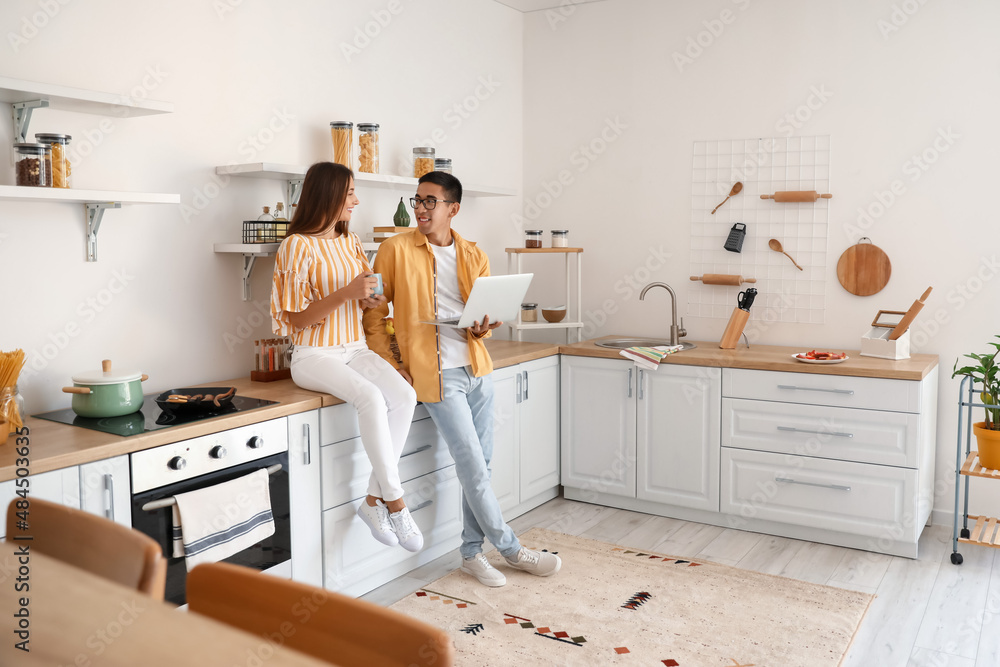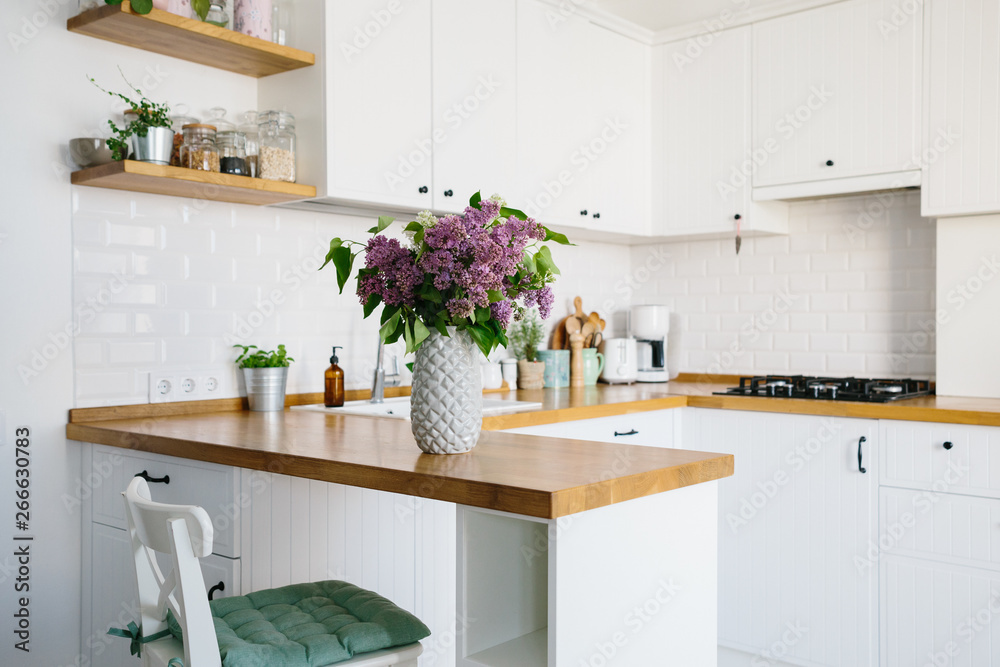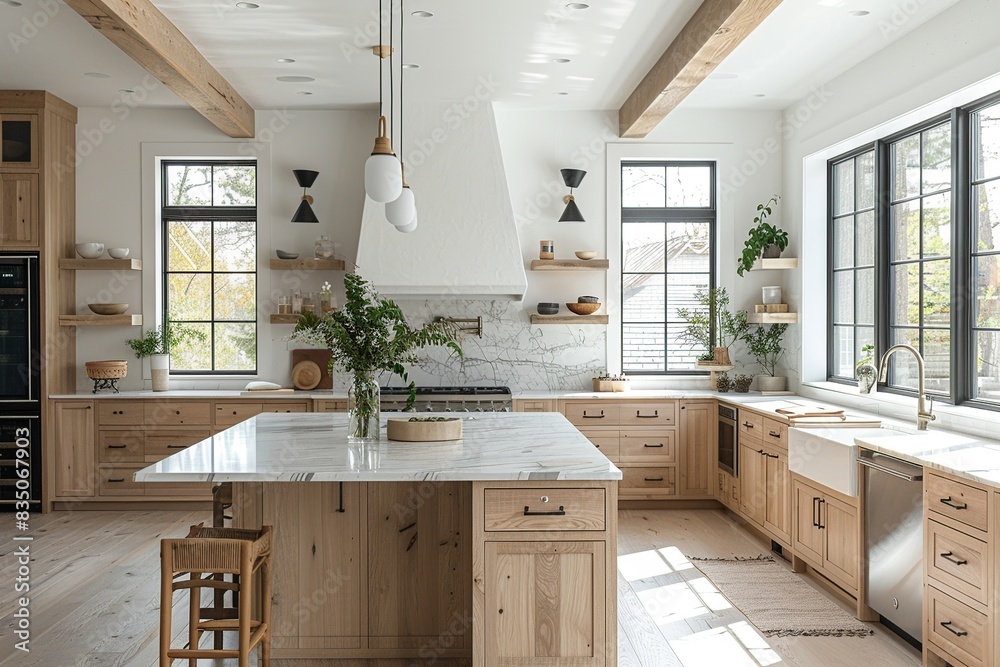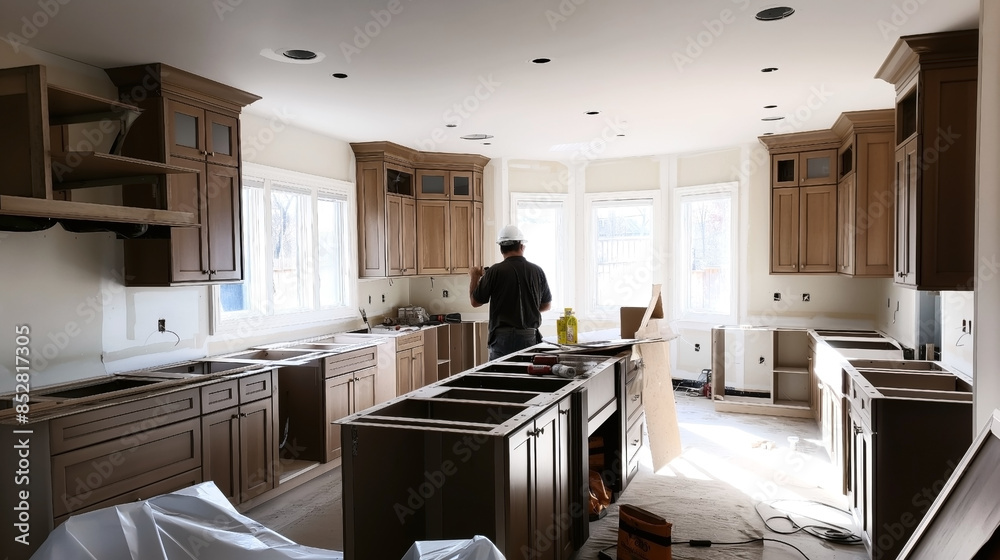1. Types of Kitchen Lighting
Overview: Kitchen lighting can be broadly categorized into three main types: ambient, task, and accent lighting. Each type serves a different purpose and, when combined, creates a layered lighting effect that enhances both functionality and aesthetics.Key Types:
Ambient Lighting:
- Purpose: Provides overall illumination for the kitchen, ensuring that the entire space is well-lit.
- Examples: Ceiling fixtures, recessed lights, and track lighting.
- Tips: Use dimmers to adjust the intensity of ambient lighting based on different activities and times of the day.
- Purpose: Focuses on specific work areas where tasks such as chopping, cooking, and reading recipes are performed.
- Examples: Under-cabinet lights, pendant lights over an island, and strip lights.
- Tips: Place task lighting directly over work surfaces to eliminate shadows and ensure adequate illumination.
- Purpose: Adds visual interest and highlights architectural features or decorative elements in the kitchen.
- Examples: Cabinet lights, toe-kick lights, and decorative pendant lights.
- Tips: Use accent lighting to draw attention to your favorite elements, such as a beautiful backsplash or glass-front cabinets.
2. Planning Your Kitchen Lighting Layout
Overview: Creating an effective lighting plan for your kitchen involves considering the room’s layout, identifying key areas that require illumination, and selecting the right fixtures to achieve a balanced and functional design.Key Considerations:
- Evaluate Your Space: Analyze the layout of your kitchen, including the location of work areas, cabinets, and appliances. Identify dark spots and areas that need more light.
- Layer Your Lighting: Combine ambient, task, and accent lighting to create a well-lit space. Ensure that each layer complements the others for a cohesive look.
- Consider Natural Light: Take advantage of natural light sources, such as windows and skylights, to enhance the overall lighting in your kitchen. Position artificial lighting to complement natural light rather than compete with it.
- Create Zones: Divide your kitchen into different zones (e.g., cooking, prep, dining) and plan lighting for each zone separately.
- Use Dimmers: Install dimmer switches for flexibility and control over the lighting intensity. This allows you to adjust the mood and functionality of the space as needed.
- Plan for Shadows: Avoid placing lighting directly behind you when working at a countertop, as this will cast shadows on your workspace.
3. Choosing the Right Fixtures
Overview: Selecting the appropriate lighting fixtures for your kitchen involves considering both functionality and style. The right fixtures can enhance the overall design of your kitchen while providing adequate illumination for various tasks.Key Fixtures:
- Ceiling Fixtures: Provide general illumination and can serve as the primary source of ambient lighting. Choose fixtures that complement the style of your kitchen.
- Recessed Lights: Ideal for providing unobtrusive ambient and task lighting. Space them evenly across the ceiling for consistent illumination.
- Pendant Lights: Perfect for task and accent lighting. Hang pendant lights over an island, dining table, or sink for focused illumination and visual appeal.
- Under-Cabinet Lights: Essential for task lighting. Install under-cabinet lights to illuminate countertops and eliminate shadows.
- Strip Lights: Versatile and can be used for task, accent, and ambient lighting. Install strip lights under cabinets, along toe-kicks, or inside cabinets for a modern touch.
- Match Fixtures to Function: Choose fixtures based on the specific needs of each area. For example, use bright, focused lights for work areas and softer, diffused lights for dining areas.
- Consider Fixture Size: Ensure that the size of the fixtures is proportionate to the space. Large fixtures can overwhelm a small kitchen, while small fixtures may not provide adequate light in a large kitchen.
- Coordinate Styles: Select lighting fixtures that complement the overall design and color scheme of your kitchen for a cohesive look.
Join HICP Homeowner’s Alliance
Connect with experts, get special discounts and enjoy member benefits
4. Understanding Light Bulbs and Color Temperature
Overview: The type of light bulbs and the color temperature you choose can significantly impact the
look and feel of your kitchen. Understanding these aspects will help you create the desired ambiance and
functionality.
Key Points:
- Types of Bulbs: Common options include incandescent, fluorescent, LED, and halogen bulbs. LED
bulbs are the most energy-efficient and have a long lifespan. - Color Temperature: Measured in Kelvins (K), color temperature ranges from warm (yellowish) to
cool (bluish) light.- Warm White (2700K-3000K): Creates a cozy and inviting atmosphere, ideal for dining
areas. - Neutral White (3500K-4100K): Provides a balanced, natural light suitable for general
use. - Cool White (5000K-6500K): Mimics daylight and is ideal for task lighting and work
areas.
- Warm White (2700K-3000K): Creates a cozy and inviting atmosphere, ideal for dining
Tips:
- Consistency: Use bulbs with the same color temperature throughout the kitchen to maintain a
cohesive look. - Energy Efficiency: Opt for LED bulbs to save energy and reduce utility bills. LEDs are
available in a variety of color temperatures and are dimmable. - Brightness: Consider the lumens (brightness) of the bulbs. Brighter bulbs are suitable for task
lighting, while softer bulbs work well for ambient lighting.
5. Incorporating Smart Lighting Solutions
Overview: Smart lighting solutions offer enhanced convenience and control, allowing you to adjust
your kitchen lighting with ease. Integrating smart technology can transform your kitchen into a modern, efficient
space.
Key Features:
- Voice Control: Use voice assistants like Alexa, Google Assistant, or Siri to control your
kitchen lighting hands-free. - Remote Control: Manage your lighting from your smartphone or tablet, whether you’re at home or
away. - Automation: Set schedules and routines for your lights to turn on or off at specific times or
in response to certain conditions (e.g., motion sensors).
Benefits:
- Convenience: Easily adjust lighting levels and settings to suit different tasks and moods.
- Energy Savings: Smart lighting can help reduce energy consumption by ensuring lights are only
on when needed. - Customization: Create personalized lighting scenes for cooking, dining, entertaining, or
relaxing.
Tips:
- Compatibility: Ensure that your smart lighting system is compatible with your existing
smart home devices and platforms. - User-Friendly Apps: Choose smart lighting solutions with intuitive apps that offer easy
control and customization. - Expandability: Select systems that allow for future expansion, so you can add more smart
lighting or devices as needed.
6. Creating a Balanced Lighting Scheme
Overview: Achieving a well-lit kitchen involves creating a balanced lighting scheme that
combines ambient, task, and accent lighting. This layered approach ensures that all areas of the kitchen are
adequately illuminated and visually appealing.
Key Strategies:
- Layered Lighting: Combine different types of lighting to create depth and dimension. Use
ambient lighting for overall illumination, task lighting for specific work areas, and accent lighting to
highlight features. - Balance Brightness: Ensure that the brightness levels of different lighting types
complement each other. Avoid overly bright or dim areas. - Focus on Key Areas: Prioritize lighting in high-use areas such as countertops, the stove,
and the sink.
Tips:
- Test and Adjust: Experiment with different lighting configurations to find the perfect
balance. Adjust fixture placement, bulb types, and dimmer settings as needed. - Reflective Surfaces: Use reflective surfaces such as glossy backsplashes, countertops, and
light-colored cabinets to enhance light distribution. - Consult a Professional: If you’re unsure about your lighting plan, consider consulting a
lighting designer or electrician to ensure optimal results.
7. Enhancing Ambiance with Decorative Lighting
Overview: Decorative lighting adds a personal touch and enhances the ambiance of your kitchen. It can serve as a focal point and contribute to the overall design aesthetic. Key Elements:- Pendant Lights: Stylish pendant lights can add character and visual interest. Hang them over an island or dining area to create a focal point.
- Chandeliers: A chandelier can add elegance and sophistication to your kitchen. Choose a design that complements your kitchen’s style.
- LED Strips: LED strips can be used to highlight architectural features, under cabinets, or along the toe-kick for a modern look.
- Aesthetic Appeal: Enhances the overall design and adds a touch of style.
- Mood Setting: Decorative lighting can set the mood for different occasions, from casual family dinners to formal gatherings.
- Customization: Allows for creative expression and personalization.
- Coordinate with Design: Ensure that decorative lighting fixtures complement the overall design and color scheme of your kitchen.
- Proportion: Choose fixtures that are appropriately sized for the space. Oversized fixtures can overwhelm a small kitchen, while small fixtures may get lost in a large kitchen.
- Layer with Functional Lighting: Combine decorative lighting with ambient and task lighting to ensure the kitchen is both beautiful and functional.
Understanding and implementing effective kitchen lighting is essential for creating a space that is both functional and stylish. By carefully planning your lighting layout, choosing the right fixtures and bulbs, incorporating smart lighting solutions, and balancing different types of lighting, you can achieve a well-lit kitchen that enhances your cooking experience and adds to the overall ambiance of your home.
Remember to layer your lighting to provide adequate illumination for all tasks, use dimmers for flexibility, and incorporate decorative elements to personalize the space. With these tips and strategies, you can transform your kitchen into a well-lit, inviting, and efficient hub for cooking, dining, and entertaining.








